Study of the Mechanical and Physical Behavior of Gypsum Boards with Plastic Cable Waste Aggregates and Their Application to Construction Panels
Abstract
1. Introduction
2. Materials and Methods
3. Results and Discussion
3.1. Young’s Modulus
3.2. Shock-Impact Resistance
3.3. Flexural Strength
3.4. Thermal Conductivity
3.5. Surface Thermal Comfort and Visual Appearance
4. Conclusions
Author Contributions
Funding
Institutional Review Board Statement
Informed Consent Statement
Data Availability Statement
Acknowledgments
Conflicts of Interest
References
- Vidales Barriguete, A. Caracterización Fisicoquímica y Aplicaciones de Yeso con Adición de Residuo Plástico de Cables Mediante Criterios de Economía Circular. Ph.D. Thesis, Universidad Politécnica de Madrid, Madrid, Spain, 2019. [Google Scholar] [CrossRef]
- Ramírez, C.P.; Merino, M.D.R.; Arrebola, C.V.; Barriguete, A.V.; Kosior-Kazberuk, M. Analysis of the mechanical behaviour of the cement mortars with additives of mineral wool fibres from recycling of CDW. Constr. Build. Mater. 2019, 210, 56–62. [Google Scholar] [CrossRef]
- Kosior-Kazberuk, M.; Krassowska, J.; Barriguete, A.V.; Rodríguez, C.P. Parámetros de la Fractura del Hormigón Reforzado con Fibras de Basalto = Fracture Parameters of Basalt Fiber Reinforced Concrete. An. Edif. 2018, 4, 52–59. [Google Scholar] [CrossRef]
- Quinchía Figueroa, A.M.; Valencia García, M.F.; Giraldo Orozco, J.M. Uso de lodos provenientes de la industria papelera en la elaboración de paneles prefabricados para la construcción. Rev. EIA 2007, 8, 9–19. [Google Scholar]
- PlasticsEurope. Plásticos—Situación en 2018. Available online: https://www.plasticseurope.org/es/resources/publications/1240-plasticos-situacion-en-2018 (accessed on 25 March 2021).
- Arandes, J.M.; Bilbao, J.; López Valerio, D. Reciclado de residuos plásticos. Rev. Iberoam. Polímeros 2004, 5, 28–45. [Google Scholar]
- De Oliveira, K.A.; Barbosa, J.C.; Christoforo, A.L.; Molina, J.C.; Oliveira, C.A.B.; Bertolini, M.S.; Gava, M.; Ventorim, G. Sound absorption of recycled gypsum matrix composites with residual cellulosic pulp and expanded polystyrene. Bioresources 2019, 14, 4806–4813. [Google Scholar]
- San-Antonio-González, A.; Merino, M.D.R.; Arrebola, C.V.; Villoria-Sáez, P. Lightweight Material Made with Gypsum and EPS Waste with Enhanced Mechanical Strength. J. Mater. Civ. Eng. 2016, 28, 04015101. [Google Scholar] [CrossRef]
- Muñoz Muñoz, D.R.; Narváez Pupiales, J.I. Construcción Sostenible a Partir de Paneles Prefabricados Utilizando yeso y Celulosa Reciclada. Bachelor’s Thesis, Universidad Central de Ecuador, Quito, Ecuador, 2019. [Google Scholar]
- Merino, M.D.R.; Sáez, P.V.; Longobardi, I.; Astorqui, J.S.C.; Porras-Amores, C. Redesigning lightweight gypsum with mixes of polystyrene waste from construction and demolition waste. J. Clean. Prod. 2019, 220, 144–151. [Google Scholar] [CrossRef]
- Suárez, F.; Felipe-Sesé, L.; Díaz, F.A.; Gálvez, J.C.; Alberti, M.G. Comportamiento a fractura de yeso con adición de fibras poliméricas. An. Mecánica Fract. 2019, 36, 114–119. [Google Scholar]
- Silva Collado, D. Propuesta de Paneles Prefabricados Para Particiones Interiores con Compuesto de yeso Reforzado con Fibras de Polipropileno Obtenidas de Residuos de Toallitas Húmedas. Bachelor´s Thesis, Universidad de Sevilla, Sevilla, Spain, 2019. [Google Scholar]
- Deng, Y.-H.; Furuno, T. Properties of gypsum particleboard reinforced with polypropylene fibers. J. Wood Sci. 2001, 47, 445–450. [Google Scholar] [CrossRef]
- Mohandesi, J.A.; Sangghaleh, A.; Nazari, A.; Pourjavad, N. Analytical modeling of strength in randomly oriented PP and PPTA short fiber reinforced gypsum composites. Comput. Mater. Sci. 2011, 50, 1619–1624. [Google Scholar] [CrossRef]
- Morales-Conde, M.; Rodríguez-Liñán, C.; Pedreño-Rojas, M. Physical and mechanical properties of wood-gypsum composites from demolition material in rehabilitation works. Constr. Build. Mater. 2016, 114, 6–14. [Google Scholar] [CrossRef]
- Alonso, Á.; Gadea, J.; Gutiérrez-González, S.; Calderón, V. Impact of Plasterboard with Ladle Furnace Slag on Fire Reaction and termal Behavior. Fire Technol. 2019, 55, 1733–1751. [Google Scholar] [CrossRef]
- Pedreño-Rojas, M.; Morales-Conde, M.; Pérez-Gálvez, F.; Rodríguez-Liñán, C. Eco-efficient acoustic and thermal conditioning using false ceiling plates made from plaster and wood waste. J. Clean. Prod. 2017, 166, 690–705. [Google Scholar] [CrossRef]
- Cherki, A.-B.; Remy, B.; Khabbazi, A.; Jannot, Y.; Baillis, D. Experimental thermal properties characterization of insulating cork–gypsum composite. Constr. Build. Mater. 2014, 54, 202–209. [Google Scholar] [CrossRef]
- Liuzzi, S.; Rubino, C.; Stefanizzi, P. Use of clay and olive pruning waste for building materials with high hygrothermal performances. Energy Procedia 2017, 126, 234–241. [Google Scholar] [CrossRef]
- Sánchez Guerrero, C.M.; Chávez Valencia, L.E. UG Rock. Jóvenes Cienc. 2017, 3, 2087–2090. [Google Scholar]
- Rossetto, J.R.D.M.; Correia, L.S.; Geraldo, R.H.; Camarini, G. Gypsum Plaster Waste Recycling: Analysis of Calcination Time. Key Eng. Mater. 2015, 668, 312–321. [Google Scholar] [CrossRef]
- Erbs, A.; Nagalli, A.; De Carvalho, K.Q.; Mymrin, V.; Passig, F.H.; Mazer, W. Properties of recycled gypsum from gypsum plasterboards and commercial gypsum throughout recycling cycles. J. Clean. Prod. 2018, 183, 1314–1322. [Google Scholar] [CrossRef]
- Pinheiro, S.M.M.; Camarini, G. Characteristics of Gypsum Recycling in Different Cycles. Int. J. Eng. Technol. 2015, 7, 215–218. [Google Scholar] [CrossRef]
- Pedreño-Rojas, M.; Flores-Colen, I.; De Brito, J.; Rodríguez-Liñán, C. Influence of the heating process on the use of gypsum wastes in plasters: Mechanical, thermal and environmental analysis. J. Clean. Prod. 2019, 215, 444–457. [Google Scholar] [CrossRef]
- Rivero, A.J.; Sathre, R.; Navarro, J.G. Life cycle energy and material flow implications of gypsum plasterboard recycling in the European Union. Resour. Conserv. Recycl. 2016, 108, 171–181. [Google Scholar] [CrossRef]
- Gómez-Rojo, R.; Alameda, L.; Rodríguez, Á.; Calderón, V.; Gutiérrez-González, S. Characterization of Polyurethane Foam Waste for Reuse in Eco-Efficient Building Materials. Polymers 2019, 11, 359. [Google Scholar] [CrossRef]
- Khalil, A.; Tawfik, A.; Hegazy, A.; El-Shahat, M. Effect of some waste additives on the physical and mechanical properties of gypsum plaster composites. Constr. Build. Mater. 2014, 68, 580–586. [Google Scholar] [CrossRef]
- Zhu, C.; Zhang, J.; Peng, J.; Cao, W.; Liu, J. Physical and mechanical properties of gypsum-based composites reinforced with PVA and PP fibers. Constr. Build. Mater. 2018, 163, 695–705. [Google Scholar] [CrossRef]
- UNE-EN 13279-1:2009. Construction Plasters and Gypsum-Based Binders for Construction. Part 1: Definitions and Specifications; Spanish Association for Standardization AENOR: Madrid, Spain, 2009. [Google Scholar]
- UNE-EN 13279-2:2014. Construction Plasters and Gypsum-Based Binders for Construction. Part 2: Test Methods; Spanish Association for Standardization AENOR: Madrid, Spain, 2014. [Google Scholar]
- UNE-EN 520:2005+A1. Sheetrock Plasterboard. Definitions, Specifications and Testing Methods; Spanish Association for Standardization AENOR: Madrid, Spain, 2010. [Google Scholar]
- UNE 102042. Construction Plasters. Other Test Methods; Spanish Association for Standardization AENOR: Madrid, Spain, 2014. [Google Scholar]
- UNE-EN 12667:2002. Construction Materials. Determination of Thermal Resistance by the Stored Hot Plate Method and the Heat Flow Meter Method. Products with High and Medium Thermal Resistance; Spanish Association for Standardization AENOR: Madrid, Spain, 2002. [Google Scholar]
- De Villanueva Domínguez, L.; García Santos, A. Manual del yeso. In Asociación Técnica y Empresarial del Yeso; ATEDY: Madrid, Spain, 2001; p. 268. [Google Scholar]
- CTE. Código Técnico de la Edificación; BOE núm 74; Spanish Ministry of Transport and Mobility: Madrid, Spain, 2006; pp. 11816–11831. [Google Scholar]
- Del Cura, S.H. Influencia de la Dosificación y Granulometría del Caucho de Neumático Fuera de uso (NFU) y de las Dimensiones Físicas en las Propiedades Térmicas, Acústicas y Mecánicas de Placas de Mortero de Yeso y Caucho. Ph.D. Thesis, Universidad Politécnica de Madrid, Madrid, Spain, 2016. [Google Scholar] [CrossRef]
- Domínguez Lepe, J.; Guemez Pacheco, D. Fabricación y evaluación de paneles aplicables a la industria de la construcción a partir del reciclaje de envases multicapa. Ingeniería 2011, 14, 191–195. [Google Scholar]
- Santos, A.G. Characterization of reinforced scagliola compounds, related to the type of reinforcement and W/P ratio. Inf. Construcción 2004, 56, 19–31. [Google Scholar] [CrossRef]
- Bicer, A.; Kar, F. Thermal and mechanical properties of gypsum plaster mixed with expanded polystyrene and tragacanth. Therm. Sci. Eng. Prog. 2017, 1, 59–65. [Google Scholar] [CrossRef]
- Mayor Lobo, P.; Bustamante Montoro, R.; Rangel, C.; Hernández Olivares, F. Propiedades térmicas, acústicas y mecánicas de placas de mortero de yeso-caucho. In Actas de II Jornadas de Investigación en Construcción; Instituto de Ciencias de la Construcción Eduardo Torroja: Madrid, Spain, 2008. [Google Scholar]
- Erdem, S.; Arioğlu, N. An Analysis of the Properties of Recycled PET Fiber-Gypsum Composites. A/Z ITU J. Fac. Arch. 2017, 14, 91–101. [Google Scholar] [CrossRef]
- Barriguete, A.V.; Merino, M.D.R.; Sánchez, E.A.; Ramírez, C.P.; Arrebola, C.V. Analysis of the feasibility of the use of CDW as a low-environmental-impact aggregate in conglomerates. Constr. Build. Mater. 2018, 178, 83–91. [Google Scholar] [CrossRef]
- Pedreño-Rojas, M.A.; Rodríguez-Liñán, C.; Flores-Colen, I.; De Brito, J. Use of Polycarbonate Waste as Aggregate in Recycled Gypsum Plasters. Materials 2020, 13, 3042. [Google Scholar] [CrossRef]
- Vidales-Barriguete, A.; Atanes-Sánchez, E.; del Río-Merino, M.; Piña-Ramírez, C. Analysis of the improved water-resistant properties of plaster compounds with the addition of plastic waste. Constr. Build. Mater. 2020, 230, 116956. [Google Scholar] [CrossRef]
- Instituto de Ciencias de la Construcción Eduardo Torroja. CSIC. Código Técnico de la Edificación—CTE. Available online: https://www.codigotecnico.org/index.html (accessed on 3 February 2021).
- Vidales-Barriguete, A.; Piña-Ramírez, C.; Serrano-Somolinos, R.; del Río-Merino, M.; Atanes-Sánchez, E. Behavior resulting from fire in plasterboard with plastic cable waste aggregates. J. Build. Eng. 2021, 40, 102293. [Google Scholar] [CrossRef]
- Diez, R.V.L.; Zaldivar, O.L.; DEL Cura, S.H.; Lobo, P.L.M.; Olivares, F.H. Influencia de la incorporación de fibras de caucho procedente de neumáticos fuera de uso (NFU) en morteros de yeso. Estudio de las propiedades mecánicas, térmicas y acústicas. DYNA Ing. E Ind. 2019, 94, 460–464. [Google Scholar] [CrossRef]
- Abu-Lebdeh, T.; Fini, E.; Fadiel, A. Thermal conductivity of rubberized gypsum board. Am. J. Eng. Appl. Sci. 2014, 7, 12–22. [Google Scholar] [CrossRef]
- Sahin, S.; Karaman, S. The Properties of Expanded Polystyrene—Pumice—Gypsum Blocks as a Building Material. J. Tekirdag Agric. Fac. 2012, 9, 51–56. [Google Scholar]
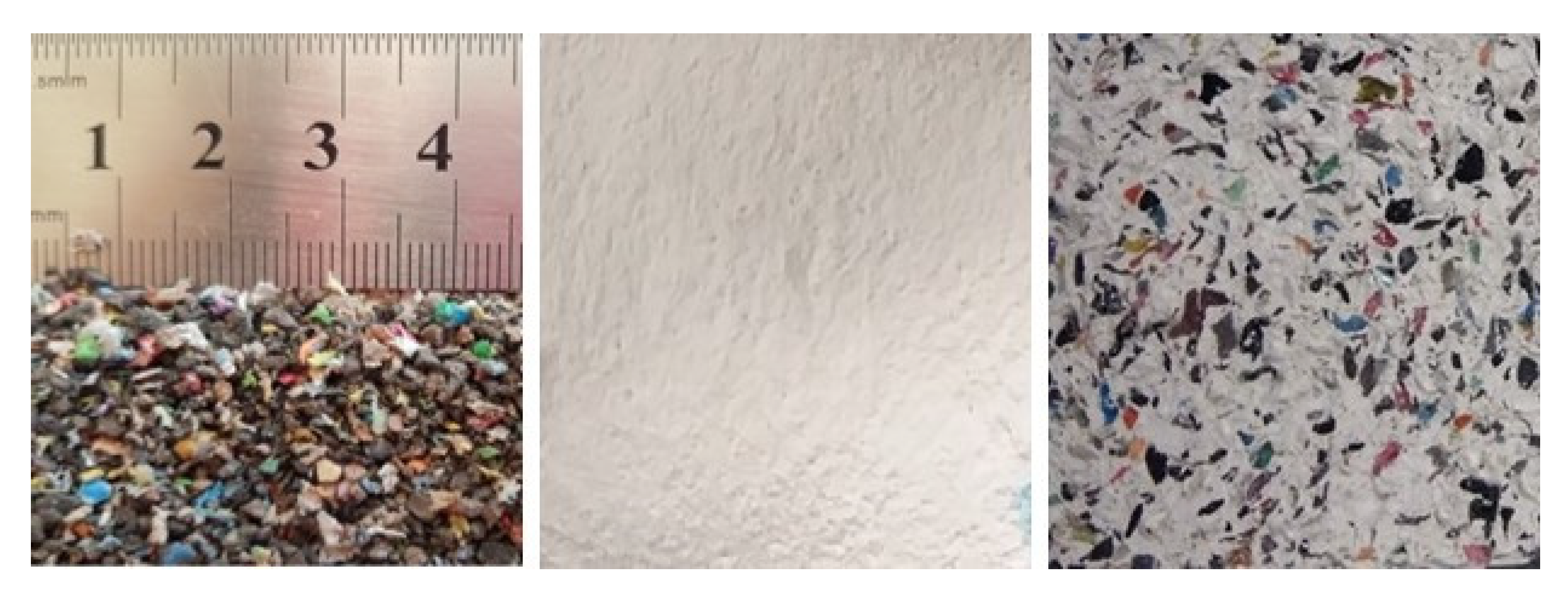
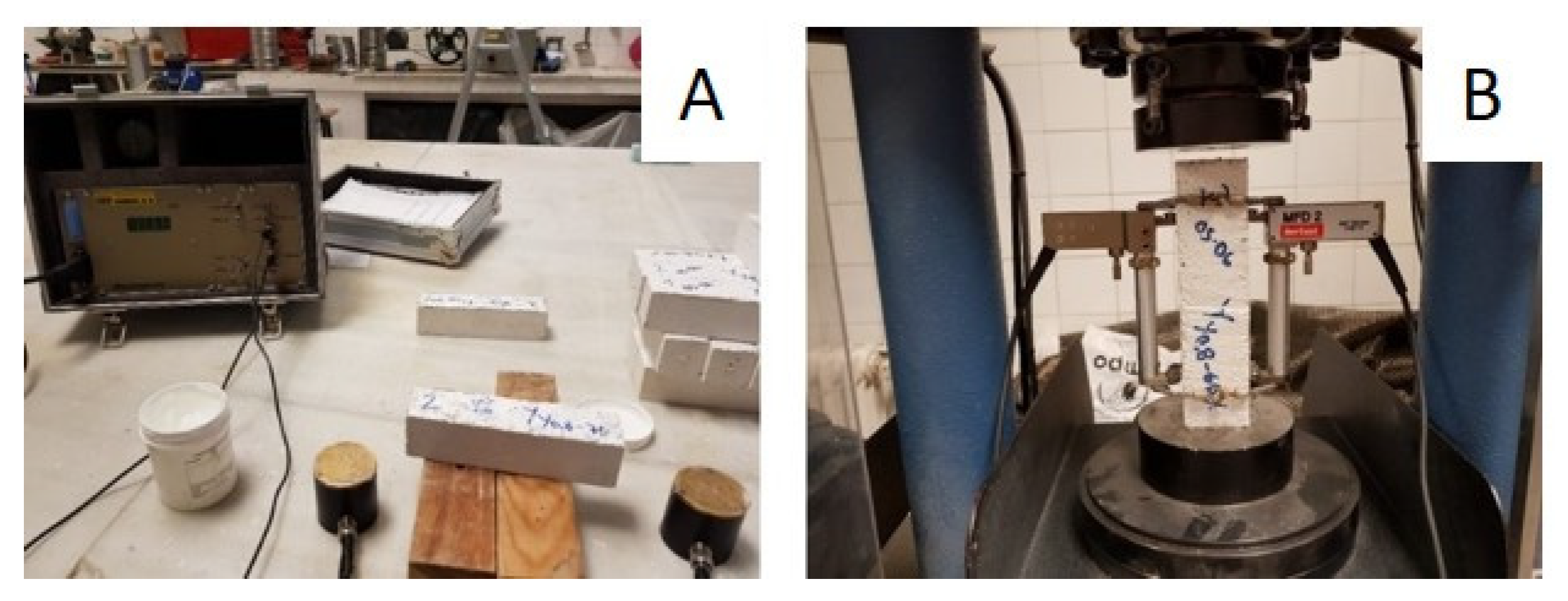

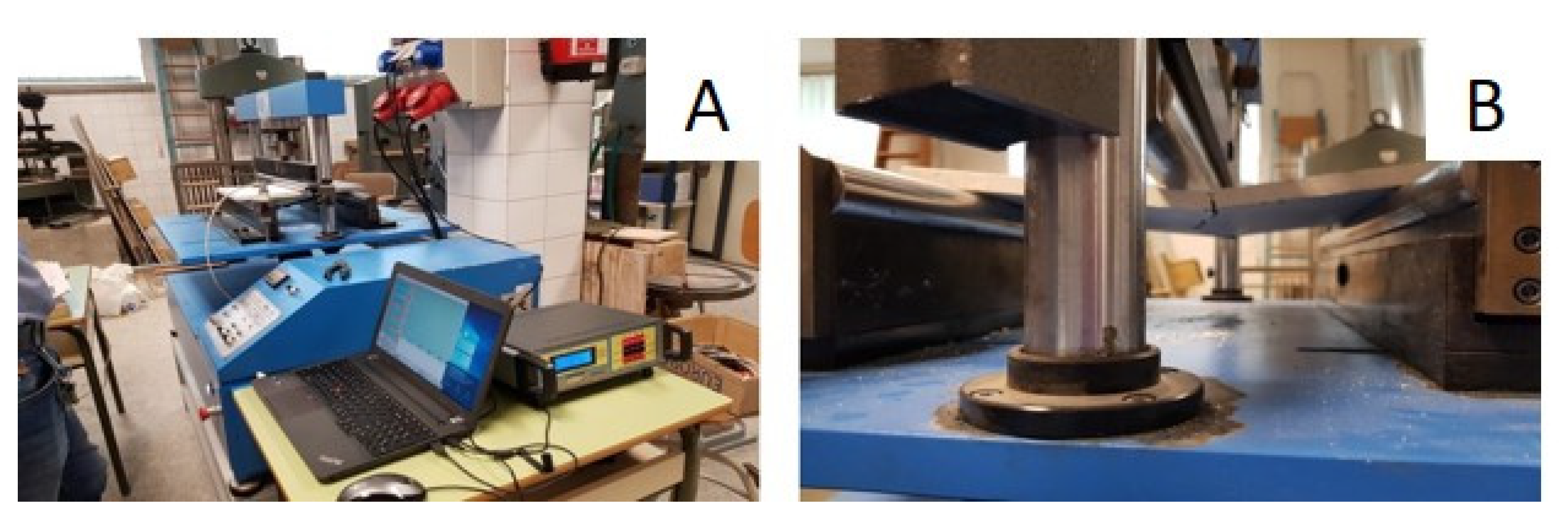
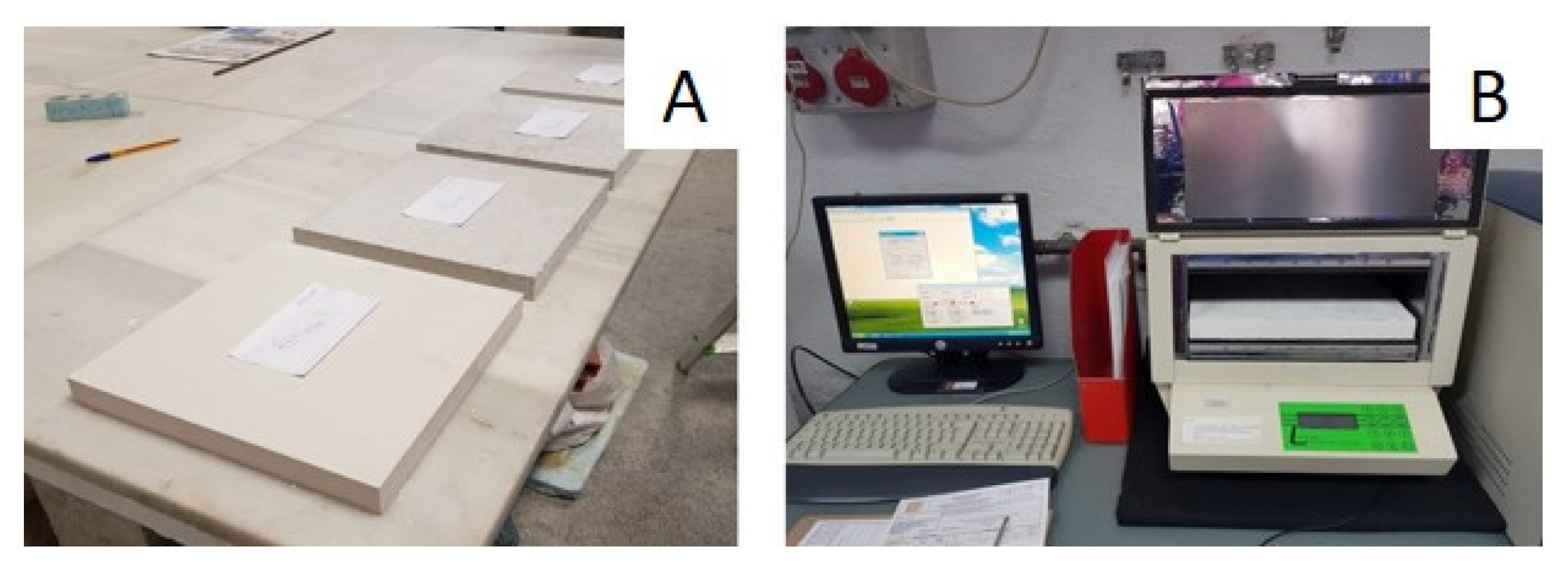


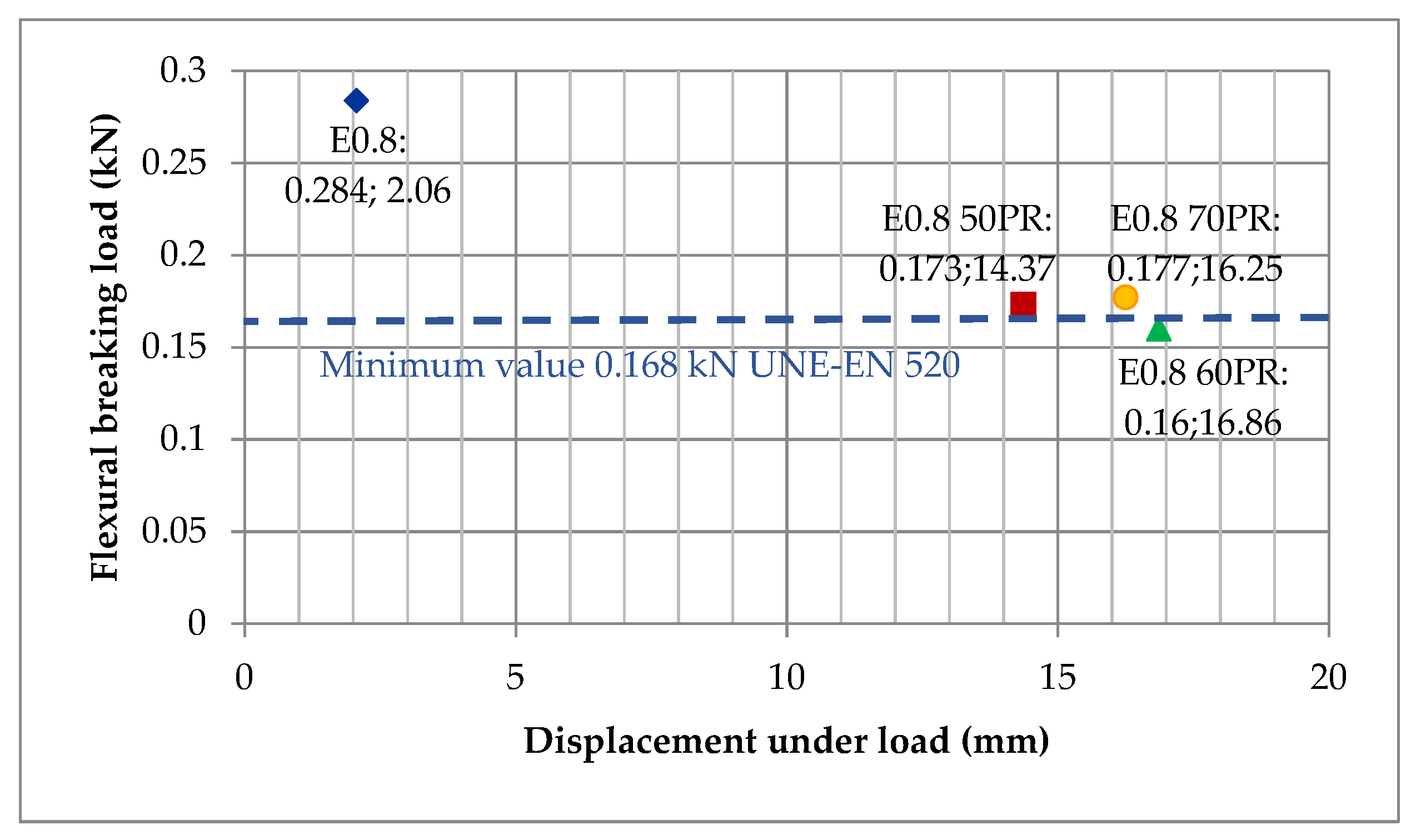
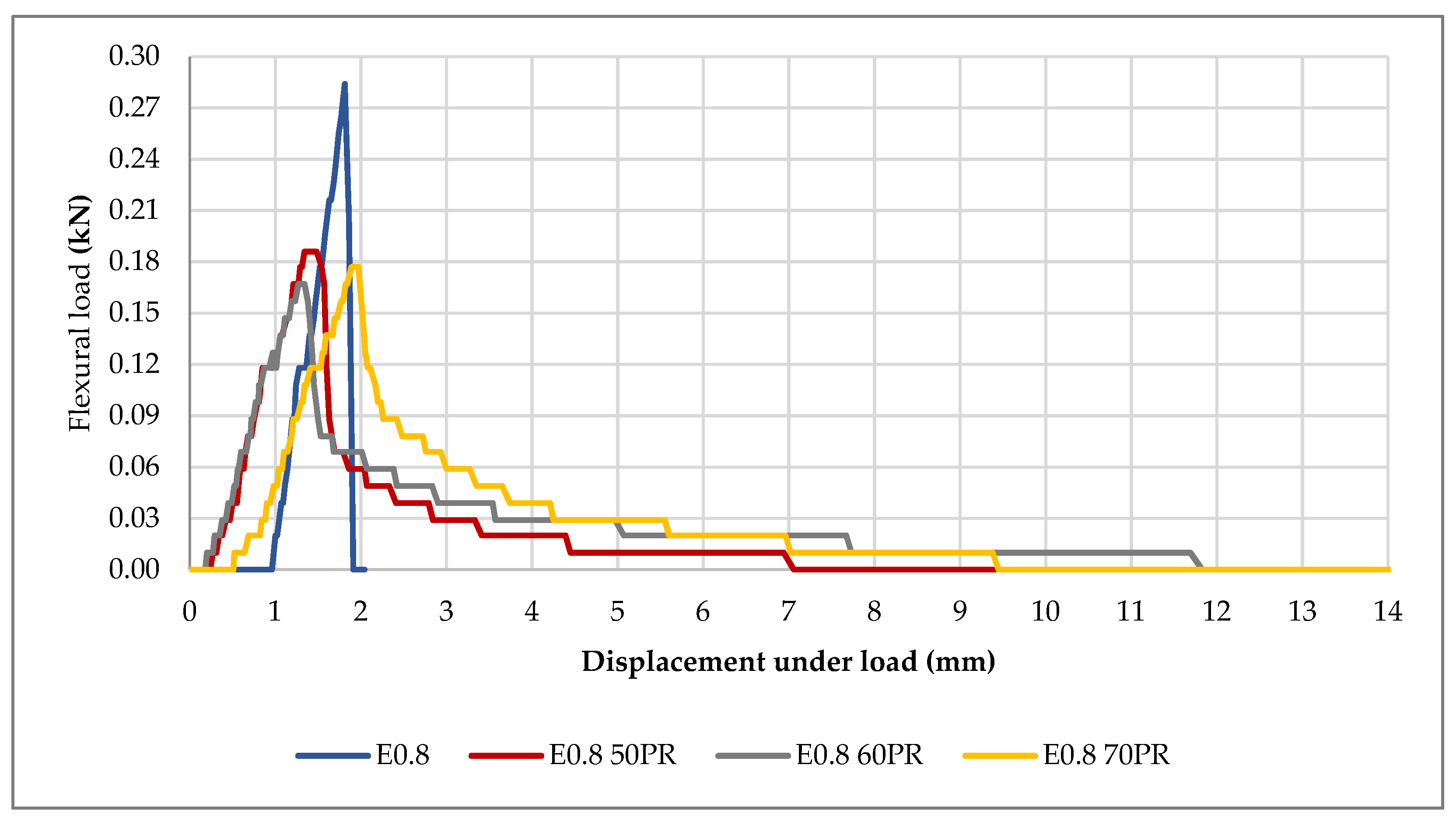

| Series | Name | PR Pellets (wt%) * | Water-to Gypsum Ratio | Dimensions ** (cm) | Test Performed |
|---|---|---|---|---|---|
| I | E0.8 | 0% | 0.8 | 16 × 4 × 4 | Young’s modulus |
| E0.8 50PR | 50% | ||||
| E0.8 60PR | 60% | ||||
| E0.8 70PR | 70% | ||||
| II | E0.8 | 0% | 0.8 | 15 × 15 × 2 | Shock-Impact Resistance |
| E0.8 50PR | 50% | ||||
| E0.8 60PR | 60% | ||||
| E0.8 70PR | 70% | ||||
| III | E0.8 | 0% | 0.8 | 40 × 30 × 1 | Flexural strength |
| E0.8 50PR | 50% | ||||
| E0.8 60PR | 60% | ||||
| E0.8 70PR | 70% | ||||
| IV | E0.8 | 0% | 0.8 | 30 × 30 × 3 | Thermal conductivity Surface thermal comfort |
| E0.8 50PR | 50% | ||||
| E0.8 60PR | 60% | ||||
| E0.8 70PR | 70% |
| Series | Name | Shore C Hardness | Mark Diameter d (mm) | Mark Depth h (mm) |
|---|---|---|---|---|
| II | E0.8 | 78 | 14.70 ± 0.40 | 1.17 ± 0.06 |
| E0.8 50PR | 81.17 | 11.68 ± 0.97 | 0.73 ± 0.11 | |
| E0.8 60PR | 80.6 | 13.70 ± 0.97 | 1.01 ± 0.14 | |
| E0.8 70PR | 81.6 | 13.18 ± 0.63 | 0.93 ± 0.09 |
| Series | Name | Flexural Breaking Load (kN) | Displacement under Load (mm) |
|---|---|---|---|
| III | E0.8 | 0.284 ± 0.02 | 2.06 ± 0.49 |
| E0.8 50PR | 0.173 ± 0.03 | 14.37 ± 1.22 | |
| E0.8 60PR | 0.160 ± 0.02 | 16.86 ± 0.69 | |
| E0.8 70PR | 0.177 ± 0.01 | 16.25 ± 0.79 |
| Series | Name | Density (kg/m3) | Thermal Conductivity—λ (W/mK) | Heat Flux (W/m2) | Thermal Resistance (m2K/W) |
|---|---|---|---|---|---|
| IV | E0.8 | 969.97 | 0.2444 ± 0.02 | 151.8 | 0.1326 |
| E0.8 50PR | 980.3 | 0.2298 ± 0.01 | 143.8 | 0.1395 | |
| E0.8 60PR | 994.27 | 0.2264 ± 0.03 | 137 | 0.1488 | |
| E0.8 70PR | 998.67 | 0.2469 ± 0.02 | 149 | 0.1346 |
| Series | Name | Specific Heat (J/kgK) | Heat Penetration Coefficient (J/(s0.5m2K)) |
|---|---|---|---|
| IV | E0.8 | 1000 | 486.89 |
| E0.8 50PR | 1000 | 474.63 | |
| E0.8 60PR | 1000 | 474.45 | |
| E0.8 70PR | 1000 | 496.56 |
Publisher’s Note: MDPI stays neutral with regard to jurisdictional claims in published maps and institutional affiliations. |
© 2021 by the authors. Licensee MDPI, Basel, Switzerland. This article is an open access article distributed under the terms and conditions of the Creative Commons Attribution (CC BY) license (https://creativecommons.org/licenses/by/4.0/).
Share and Cite
Vidales-Barriguete, A.; Santa-Cruz-Astorqui, J.; Piña-Ramírez, C.; Kosior-Kazberuk, M.; Kalinowska-Wichrowska, K.; Atanes-Sánchez, E. Study of the Mechanical and Physical Behavior of Gypsum Boards with Plastic Cable Waste Aggregates and Their Application to Construction Panels. Materials 2021, 14, 2255. https://doi.org/10.3390/ma14092255
Vidales-Barriguete A, Santa-Cruz-Astorqui J, Piña-Ramírez C, Kosior-Kazberuk M, Kalinowska-Wichrowska K, Atanes-Sánchez E. Study of the Mechanical and Physical Behavior of Gypsum Boards with Plastic Cable Waste Aggregates and Their Application to Construction Panels. Materials. 2021; 14(9):2255. https://doi.org/10.3390/ma14092255
Chicago/Turabian StyleVidales-Barriguete, Alejandra, Jaime Santa-Cruz-Astorqui, Carolina Piña-Ramírez, Marta Kosior-Kazberuk, Katarzyna Kalinowska-Wichrowska, and Evangelina Atanes-Sánchez. 2021. "Study of the Mechanical and Physical Behavior of Gypsum Boards with Plastic Cable Waste Aggregates and Their Application to Construction Panels" Materials 14, no. 9: 2255. https://doi.org/10.3390/ma14092255
APA StyleVidales-Barriguete, A., Santa-Cruz-Astorqui, J., Piña-Ramírez, C., Kosior-Kazberuk, M., Kalinowska-Wichrowska, K., & Atanes-Sánchez, E. (2021). Study of the Mechanical and Physical Behavior of Gypsum Boards with Plastic Cable Waste Aggregates and Their Application to Construction Panels. Materials, 14(9), 2255. https://doi.org/10.3390/ma14092255









